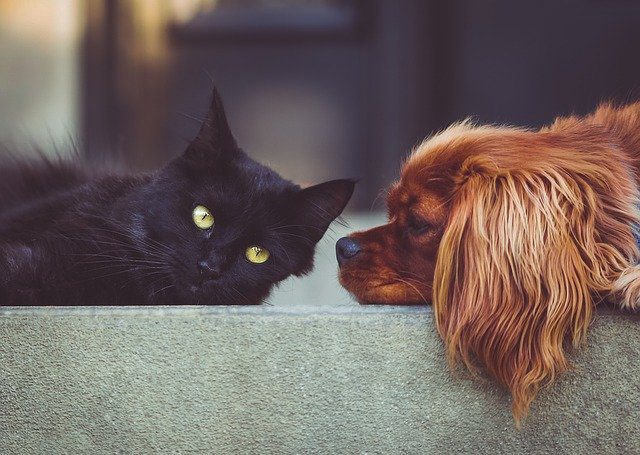Circumstances in which we find ourselves can change drastically, and so do our preferences. Did you always consider yourself a cat person and later discover that you’d like to have a dog, too? Or maybe you already own one of these pets and, due to an unexpected surprise, have to take care of the other one as well? No matter the reason for both a cat and a dog living in your house, there’s one thing for sure: they will have to learn how to get along.
The good news is that most dogs can learn to live peacefully with cats and even become best friends. However, some are a tad bit more difficult to train than others. A lot depends on the breed and the age. It can make a lot of difference if your dog is a friendly labrador or a high-energy, playful terrier who is hard-wired to chase down prey, or a puppy from foufoupuppies such as an unsuspecting cat. What is more, starting with a small puppy and a kitten should be easier on you as a pet owner than trying to turn two adult pets into friends.
Are cats and dogs natural enemies? Perhaps. Do they have to be mortal foes? Absolutely not. Read on to find out how you can turn these two very different species into best friends, improve household relations, and help your pets live their best lives in perfect harmony.
Table of Contents
Create a Safe Spot
Before you start with the training, make sure to establish a few safe spots for your cat, where it can run and hide from your dog if it feels unsafe or threatened. While picking these “base camps,” keep in mind that your dog shouldn’t have access to them. This can be achieved by using a baby gate which will help separate the two animals.
Elevated areas, like the top of a refrigerator, a bookshelf, or a window perch, are recommended, as they’re usually out of most dogs’ reach. Apart from safe spots, you should also make sure that you have two different locations to feed your cat and dog. Keeping the cat’s litter box in a place where the dog can’t access it is also essential. Both cats and dogs are territorial animals. Therefore they enjoy having their own private spaces.
If you notice that despite providing your cat with several different safe spots, it still tends to be anxious in the dog’s presence, try using natural products like catnip or dried chamomile flowers. CBD oil for dogs also works great, as its anti-anxiety properties have been proven to be very effective and should help bring your nervous pet some much-needed stress relief.
Take Personalities Into Account
While the breed of the pets plays a relevant role in the training, their personalities and energy levels are just as important. For example, it’s better to introduce a puppy to a kitten than try to arrange a positive first meeting of a new kitten and elderly dog. Also, an aging territorial dog won’t be a good fit in a house where a skittish cat already lives, whereas a boisterous puppy will get on the old cat’s nerves.
Suppose you happen to find yourself in a situation where your animals end up being two opposites. In that case, you should have a solid backup plan that will allow you to keep them separated for most of the time, without drastic limitations to the space that they occupy. However, it might prove helpful to allow them to see each other through a baby gate from time to time to test their reactions before you decide if your pets are ready for the face-to-face introduction and spending more time in the same room.
When talking about personalities, it’s also worth noting that they change with age. Therefore, if possible, if you have a puppy, it’s great to introduce them to a kitten. Similarly, an adult cat will find it easier to adapt to the new situation if their new flatmate is an adult dog.
Obedience Training
In most cases, the dogs are the biggest troublemakers. It’s because they have a higher prey drive, making them chase everything small and fluffy. Obedience training is a way to curb this behavior. There’s no other way around it: your dog must learn that chasing cats is not acceptable. That’s why proper training is essential to help them get along better.

First and foremost, remember that cats and dogs are very different animals, and you cannot train them using the same techniques. Dogs respond well to treats and encouragement, while cats often react better to praise and consistent rules with strict consequences.
Start by teaching your dog commands like “sit” and “stay.” They’re easy enough that even puppies understand them. These basic commands will help you bolster calm behavior and handle your dog more easily in the cat’s presence. You can reward both pets with tasty treats to encourage self-control and help them associate their good behavior with a positive situation.
Another way to train obedience is by introducing “the ignore method.” With your dog on a leash, have him sit by your side. Then, have someone (a friend or a family member) bring the cat into the same room. If the dog remains calm when seeing the cat, you should praise him and reward the good behavior with pets and a treat. If the dog starts barking or tries to leave your side, say, “leave it!”. Then you can try to bring the cat closer while closely monitoring your dog’s behavior. This method works well for both adult cats and dogs, as well as for puppies and kittens. It’s also an excellent way to introduce dogs to other animals.
Encouraging a Long-term Friendship
As soon as your cat feels safe with the dog’s presence, you can start exercises that will help them get along better while you’re not around. Once your dog learns to behave appropriately both on and off the leash, you can try allowing both pets to roam the same space freely. If you can’t be at home at all times to supervise them, especially in the beginning, you can get a pet sitter who will look after your cat and dog as nannies take care of kids. Remember to continue praising and rewarding good behavior with treats, pets, and toys, but try to avoid the noisy ones, especially if one of your pets is elderly. A squeaky toy can quickly get on their nerves.
All pet owners must remember that even when it seems like their cats and dogs can already co-exist without constant supervision or stay home alone without a pet sitter, safety still should be the number one priority. To avoid scratching or minimize the damage stemming from a possible fight:
- Consider trimming your cat’s claws, but don’t try to do it yourself, as trained professionals should only do it.
- Give your playful cat access to plenty of toys so that when bored, it will leave the dog alone.
- Find a fun game that you can play with both a dog and a cat to create as many positive situations between them as possible.
Conclusion
Remember to be patient and flexible. Training takes time and effort, and your pet might not learn everything during the first session. Don’t get frustrated and give up, but rather think of it as a process and be consistent. It will take time, but you can teach your cat and dog to get along together peacefully if you follow these steps.
Featured Image by StockSnap on Pixabay




